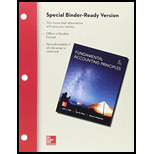
Concept explainers
Concept Introduction:
Costs assigned to Units transferred and units in ending inventory:
The costs are assigned to units transferred and units in ending inventory on the basis of equivalent units in materials and conversion and cost per units assigned.
The costs assigned to units transferred are calculated as under –
The costs assigned to ending inventory are calculated as under –
To assign:
Costs to the assembly department’s output for –
1. Units transferred out to painting department
2. Units in ending inventory (units that remain n process in the assembly department at month-end)
Answer to Problem 16QS
Solution:
Costs assigned for –
1. Units transferred out to painting department = $ 16,590
2. Units in ending inventory = $ 3,663
Explanation of Solution
The costs assigned to units transferred out to painting department and to units in ending inventory are calculated as under –
1. Costs assigned to units transferred out to painting department –
Given,
• Equivalent units for units transferred for materials = 7,000 units
• Equivalent units for units transferred for conversion = 7,000 units
• Cost per equivalent unit for materials = $ 1.02 per unit
• Cost per equivalent unit for conversion = $ 1.35 per unit
•
The costs assigned to units transferred out to painting department are = $ 16,590
2. Costs assigned to units that remain in assembly department (Ending inventory units) –
Given,
• Equivalent units for ending inventory for materials = 2,400 units
• Equivalent units for ending inventory for conversion = 900 units
• Cost per equivalent unit for materials = $ 1.02 per unit
• Cost per equivalent unit for conversion = $ 1.35 per unit
•
The costs assigned to units that remain in assembly department (Ending inventory units) are = $ 3,663.
Thus, the costs to the assembly department’s output for units transferred out to painting department and units in ending inventory (units that remain n process in the assembly department at month-end) have been assigned.
Want to see more full solutions like this?
Chapter 20 Solutions
Loose Leaf for Fundamentals of Accounting Principles and Connect Access Card
- How many units were completed during September?arrow_forwardWhat is the difference between accrual accounting and cash basis accounting?explainarrow_forwardKodak Inc. sells its product for $95 per unit. During 2023, it produced 85,000 units and sold 68,000 units (there was no beginning inventory). Costs per unit are: direct materials $22, direct labor $19, and variable overhead $6. Fixed costs are: $1,275,000 manufacturing overhead, and $127,000 selling and administrative expenses. The per-unit manufacturing cost under absorption costing is__.arrow_forward
- Bill Inc., wants to make a profit of $25,000. It has variable costs of $80 per unit and fixed costs of $15,000. How much must it charge per unit if 4,000 units are sold? a. $85 b. $105 c. $100 d. $90arrow_forwardI am searching for the accurate solution to this general accounting problem with the right approach.arrow_forwardFinancial Accounting questionarrow_forward
- Did Owner's Equity increase or decrease?arrow_forwardA company had cash sales of $54,650, credit sales of $39,320, sale returns and allowances of $8,220, and sales discounts of $5,200. What is the company's net sales for this period?arrow_forwardCan you help me solve this general accounting question using valid accounting techniques?arrow_forward

 AccountingAccountingISBN:9781337272094Author:WARREN, Carl S., Reeve, James M., Duchac, Jonathan E.Publisher:Cengage Learning,
AccountingAccountingISBN:9781337272094Author:WARREN, Carl S., Reeve, James M., Duchac, Jonathan E.Publisher:Cengage Learning, Accounting Information SystemsAccountingISBN:9781337619202Author:Hall, James A.Publisher:Cengage Learning,
Accounting Information SystemsAccountingISBN:9781337619202Author:Hall, James A.Publisher:Cengage Learning, Horngren's Cost Accounting: A Managerial Emphasis...AccountingISBN:9780134475585Author:Srikant M. Datar, Madhav V. RajanPublisher:PEARSON
Horngren's Cost Accounting: A Managerial Emphasis...AccountingISBN:9780134475585Author:Srikant M. Datar, Madhav V. RajanPublisher:PEARSON Intermediate AccountingAccountingISBN:9781259722660Author:J. David Spiceland, Mark W. Nelson, Wayne M ThomasPublisher:McGraw-Hill Education
Intermediate AccountingAccountingISBN:9781259722660Author:J. David Spiceland, Mark W. Nelson, Wayne M ThomasPublisher:McGraw-Hill Education Financial and Managerial AccountingAccountingISBN:9781259726705Author:John J Wild, Ken W. Shaw, Barbara Chiappetta Fundamental Accounting PrinciplesPublisher:McGraw-Hill Education
Financial and Managerial AccountingAccountingISBN:9781259726705Author:John J Wild, Ken W. Shaw, Barbara Chiappetta Fundamental Accounting PrinciplesPublisher:McGraw-Hill Education





